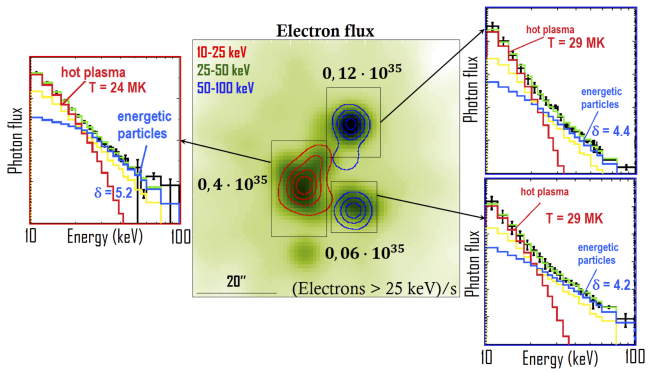Electron Scattering in the Flaring Corona
| Nugget | |
|---|---|
| Number: | 309 |
| 1st Author: | Sophie Musset |
| 2nd Author: | |
| Published: | 24 October 2017 |
| Next Nugget: | Valderrama in the 21st Century |
| Previous Nugget: | The Power of Turbulence |
Introduction
The physics of Solar flares depends upon the acceleration of particles to energies far above that of the ambient medium; even in the corona the thermal particle energy may be of order 0.1 keV (or less), whereas the bremsstrahlung hard X-ray spectrum of energetic electrons in a flare may extend to well above 100 keV. The X-ray and radio emissions from these electrons do not come directly from the site of their acceleration. From this site they must propagate, guided by the magnetic field, and emit gyro-synchrotron emission in radio and bremsstrahlung emission in X-rays during this propagation. Transport effects can change the properties of electron populations between acceleration site and emission sites.
Electron transport in a flaring loop
Imaging spectroscopy with RHESSI allows us to study the transport effects on energetic electron distributions in coronal flaring magnetic loops, if the X-ray emission from the coronal part of the loop is bright enough to be observed by RHESSI in the presence of the chromospheric footpoint emission. Such looptop emission could be present if the source can be collisionally thick, for example can remain trapped for a sufficiently long time to slow down via collisional interactions with the ambient plasma.
The flare SOL2004-05-21 was such a "coronal thick-target" flare, with two footpoints and a coronal looptop X-ray source all visible in the RHESSI hard X-ray images (see Figure 1). Imaging spectroscopy on the three sources reveals that non-thermal emission is present in all the sources; however, the properties of the non-thermal spectrum of energetic electrons differ from those in the footpoint sources: the spectrum is harder in the footpoints, and the electron rate is greater in the looptop source. This last observation suggests that energetic electrons are indeed trapped in the coronal part of the loop.

The conclusions here agree with observation and modeling of the gyrosynchrotron emission of the same flare, which showed that energetic electrons are trapped near the looptop at the time of the peak of the flare [Ref. 1]. However, the ratio between the density of energetic electrons in the looptop to the density in the footpoints is higher for radio-emitting electrons than for X-ray-emitting electrons, by a factor of about 3 (see Figure 2). Does this mean that the trapping mechanism is more efficient for the few-hundred-keV electrons emitting radio than for the few tens-of-keV electrons emitting hard X-rays?
[[File:309f2.png|550px|thumb|center|Figure 2: Distribution of the density of energetic electrons above 25 keV, deduced